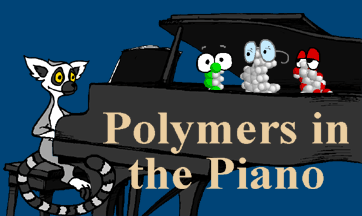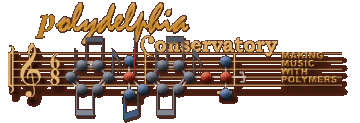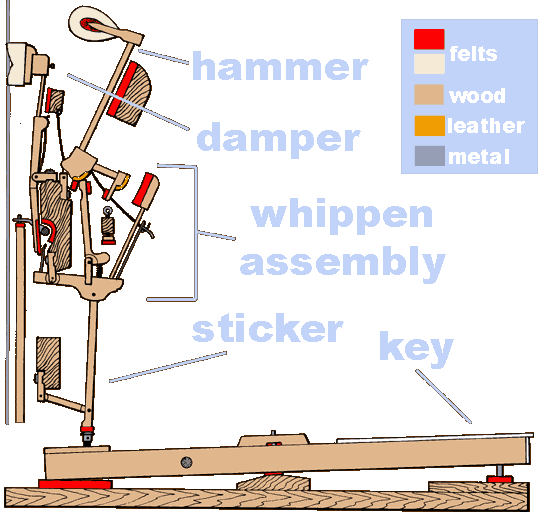 Most of the insides of this piano are made of
Most of the insides of this piano are made of
polymers!
|
Pianos are packed with polymers! The main thing that vibrates in a piano to make a sound - the strings - are not polymers. They are steel wires, and some of them - the largest ones - are wrapped in copper coils. But these strings are not all it takes to generate sound. Most of the rest of the ingredients in pianos are - you guessed it - polymers!
The outside casing of a piano and the frame that the keyboard, action and harp sit in is made of strong dense wood like oak. Wood is a form of cellulose, a natural polymer. The cabinet of the piano is what makes it look pretty, especially if the finish is kept shiney and scratch free. Most pianos have a coat of clear laquor made from a synthetic polymer. Some of the more popular choices for making a pinao shiny and protecting the wood are nitrous cellulose, polyurethane, or (more rarely) polyester, which is very durable and smooth, and also expensive due to the time it takes to polish it to a glassy shine.
 The keytops, the finish and the name decal on
The keytops, the finish and the name decal on
this piano are all polymers.
|
Key tops used to be made from ivory, a polymer made of hard proteins. Ivory, which comes from elephant tusks, has a nice smooth feel and looks pretty, but now it is illegal to use it. So most new key tops are some kind of hard plastic like polystyrene. The same goes for the black keys, which were traditionally made of wood (namely ebony), but now are most often black plastic. The key itself, which is basically a long lever that goes far back into the piano to push the action is made of some sort of lightweight wood.
The keys - when pressed - activate a set of parts called the "action," a fairly complex assembly of wooden elements such as shanks and flanges with metal pins in their pivot points. In some newer piano a few of the action parts can be made from tough ABS plastic.
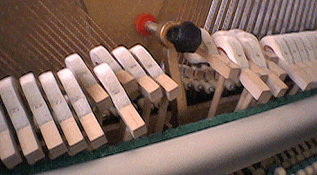 Felt hammers in a piano are different sizes
Felt hammers in a piano are different sizes
for different notes.
|
The action essentially moves a hammer that strikes the appropriate set of strings to sound a note. The hammers are made of wood with dense felt heads made from wool fibers - another natural polymer.
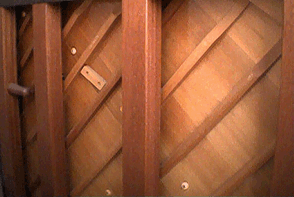 The spruce soundboard in the back
The spruce soundboard in the back
of an upright is what generates
the sound you hear.
|
Though the strings do all the vibrating that initiates the sound, the sound that you really hear from a piano comes from the soundboard - in the back of an upright or the underside of a grand. It is made of spruce wood - more cellulose - and composed of a set of boards about 3/8" thick. They are held together by a set of "ribs" on the back. The strings are connected to the spruce via a set of hardwood bridges that conduct the vibrations of the strings into the wood and cause the entire soundboard to vibrate. Without it, a piano would sound like... well not much at all. Pure tone from a vibrating string isn't really very loud
Just the same way the strings vibrate the soundboard, they have a tendency to vibrate the whole piano and all its parts. That wouldn't sound too pretty, so there is just as much done in the construction of a piano to PREVENT noise as there is to cause it.
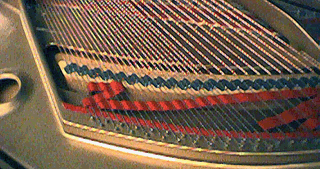 Grand and upright pianos are full of pretty
Grand and upright pianos are full of pretty
felt that comes in a variety of colors.
|
The best way is to insulate all the parts that might rub together or rattle against one another, especially where there are moving parts that have to sit right up against each other. Felt or leather is used on all the little bits of action that have to hit each other or pivot to move the hammers and dampers, so that the parts don't click together or make scraping noises as they move. Felt is also used in major joints where large parts of the piano fit together and might vibrate against one another. If you look closely, you can see brightly colored felt in lots of places, especially in a grand piano with the lid opened up. It is all to prevent unwanted rattles and vibrations.
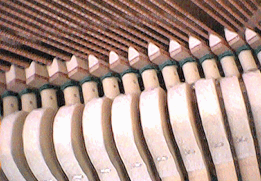 A felt damper sits on each set of strings
A felt damper sits on each set of strings
until the note is played
|
Another VERY important place where felt is used is in the dampers. These are mutes that sit on all but the very highest treble strings. They keep the sound board from vibrating the rest of the strings when one string is sounded. If it weren't for dampers, playing one note on a piano would cause the rest of the notes to ring and make a strange string echo noise. When a key is played, the action lifts the damper off that one string and holds it up for as long as the key is depressed. If a damper is malfunctioning and doesn't lift, the string is unable to vibrate and just makes a weird dull "thunk" sound when the key is played.
Making a piano takes an awful lot of glue. To hold the main parts together polyvinyl chloride (PVC) is used, in other places various epoxy resins are used, such as on the soundboards and ribs. To glue porous parts such as felts to wood as well as to hold wood parts together, the usual choice is called hide glue. It is made from horse hide and melts to the proper consistency when heat and water are added. It also comes in a liquid which doesn't require heating. This glue is tough and flexible enough to stand up to temperature and humidity changes. Contact cement, usually made from neoprene rubber, is used to put the key tops on and to glue large parts in place, while other epoxies like polyester fiberglass can be used to fill holes in wood or gaps between parts.
